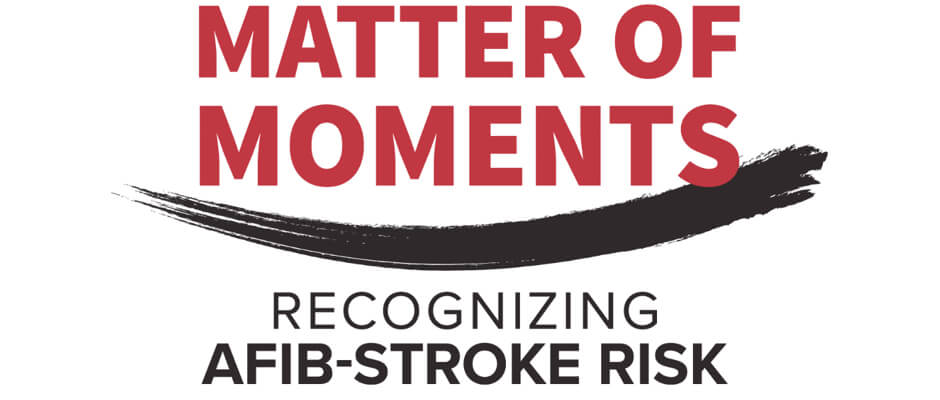Matter of Moments: Recognizing AFib-Stroke Risk

AFib Fast Facts:
|
Millions of Americans are estimated to live with a common type of irregular heartbeat called atrial fibrillation (AFib).1 In fact, in 2019 approximately 8 million people in the U.S. are projected to be affected by AFib.2 However, some of these people may not know they have it because the condition can have no symptoms.1 The prevalence of AFib is higher in people aged 65 and older – about 9% of people in this age group have the condition.1 Some additional risk factors for AFib include diabetes, high blood pressure and certain heart disease (e.g., congestive heart failure, coronary artery disease).1,3

Why is awareness of AFib and its risk factors so important? Because those with AFib have up to a five times greater chance of stroke than those without the condition5,6 and strokes related to AFib are more likely to be severe than non-AFib-related strokes.5,7
The Bristol-Myers Squibb-Pfizer Alliance established an awareness initiative in late 2018, called Matter of Moments: Recognizing AFib-Stroke Risk. Why “Matter of Moments?” Because in a matter of moments, the lives of individuals, as well as their family and friends, can be affected by AFib-related stroke. On the other hand, AFib may also be detected in a matter of moments as a part of routine medical care.
The Alliance created the Matter of Moments initiative to help raise awareness of AFib, its connection to stroke, and the importance of a timely AFib diagnosis. We are doing this by collaborating with expert health-care professionals and advocacy organizations so that patients and health-care providers can be better prepared for a future where AFib may be more prevalent.
Visit AMatterofMoments.com to learn more about AFib and stroke risk.
References:
- Centers for Disease Control and Prevention (CDC). Atrial fibrillation fact sheet. https://www.cdc.gov/dhdsp/data_statistics/fact_sheets/fs_atrial_fibrillation.htm. Accessed March 1, 2019.
- Colilla S, Crow A, Petkun W, Singer DE, Simon T, Liu X. Estimates of current and future incidence and prevalence of atrial fibrillation in the U.S. adult population. Am J Cardiol. 2013;112(8):1142–1147.
- Heart Rhythm Society. Risk factors for atrial fibrillation. https://www.hrsonline.org/Patient-Resources/Heart-Diseases-Disorders/Atrial-Fibrillation-AFib/Risk-Factors-for-AFib.
- National Heart, Lung, and Blood Institute (NHLBI). Atrial fibrillation. https://www.nhlbi.nih.gov/health-topics/atrial-fibrillation. Accessed March 1, 2019.
- January CT, Wann LS, Alpert JS, et al.American College of Cardiology/American Heart Association Task Force on Practice Guidelines. 2014 AHA/ACC/HRS guideline for the management of patients with atrial fibrillation. A report of the American College of Cardiology/American Heart Association Task Force on practice guidelines and the Heart Rhythm Society. J Am Coll Cardiol. 2014;64(21):e1-e76.
- Wolf PA, Abbott RD, Kannel WB. Atrial fibrillation is an independent risk factor for stroke: The Framingham Study. Stroke. 1991;22(8):983-988.
- Lin H-J, Wolf PA, Kelly-Hayes M, et al. Stroke severity in atrial fibrillation: The Framingham Study. Stroke. 1996;27(10):1760-1764.
![]()
